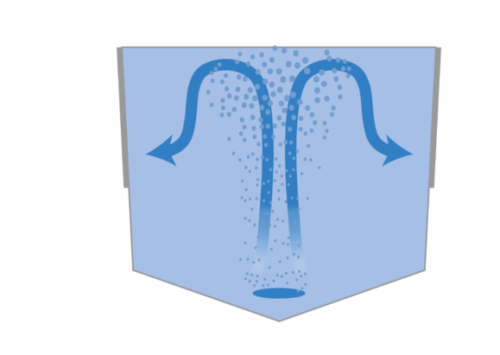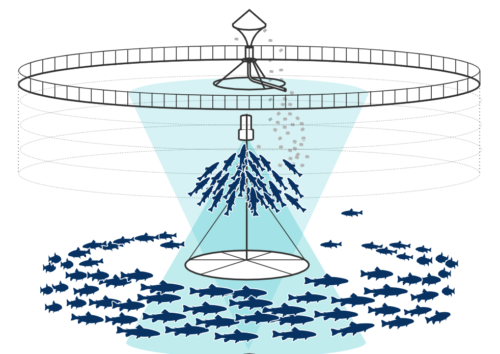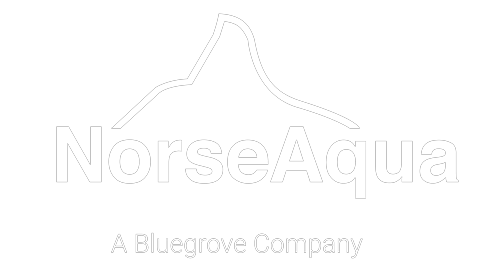Fish jacuzzis can improve the lives of both salmon and farmers, and they work well with efforts to get rid of sea lice.
By Simon Kveinå – Farming Equipment Expert in Bluegrove
Water quality matters to us all, though for farmed salmon it is a matter of life and death.
Unlike other fish species that have evolved to inhabit slow-running or stagnant water, salmon simply cannot and will not tolerate poor water quality. It affects their growth, their health and welfare, and their ability to use their gills. In extreme situations, poor quality water can lead to death.
Salmon farmers know this, but they also know about other problems that harm salmon, such as sea lice. Sometimes, farmers use lice skirts to prevent sea lice from entering the salmon cages, or tubenets to make the salmon swim down to a water level below which sea lice can be found. These are efficient solutions to that particular problem.They can amplify another problem, however, if they prevent the water from flowing freely thus resulting in stagnant water and decreased water quality within the cage or the tube.
Fortunately, farmers don’t have to choose which of these two problems to tackle first. Both can be tackled at the same time. Thanks to sophisticated undercage aeration technology, which improves water quality by lifting water into the cage from below, farmers can keep the lice skirts and tubenets in place, thereby protecting the fish against sea lice in an environment that encourages growth and safeguards health and welfare standards.
The process involves additional air being pumped into the cage where it helps the water circulate, which in turn creates a more homogenous environment throughout the water column. It is suitable for cages with or without lice skirts.

All of that might sound simple, but there are still a few things that farmers who wish to make good use of the technology should consider:
1: Farm design
No two fish farms are the same, as they are invariably placed in waters where conditions differ. In places such as the Nordics, Canada and Chile, the oceans provide excellent growth and living conditions for salmon. It is nevertheless important to understand how the natural ebbs and flows of the sea can either help or hinder operations.
With this in mind, the farms must be designed in ways that take full advantage of the natural movement of the ocean, as this can help prevent the water from becoming stagnant. When lice control measures are used, it can be difficult nonetheless to ensure sufficient water flow to the upper levels of the cage, even in the best natural environments. Having a bespoke cage that has been well designed from the outset is an excellent start as the farmer strives to achieve the best water quality possible.
2: Measure and monitor
There are a multitude of reasons why a fish farming site might experience poor water quality. Stagnant water flow is one of them, though algae and jellyfish may also reduce water quality to the detriment of the health and welfare of the fish.
To make sure the water is of good quality, farmers regularly check key indicators such as oxygen saturation, temperature and salinity. Other water quality challenges, such as low pH, buffer capacity and low oxygen levels, must also be monitored, as they can severely affect the salmon’s gills and the time it takes to delouse the fish.
When these measurements are off, farmers have to respond. They sometimes do this by removing the lice skirts or tubenets, thus ending the delousing process earlier than intended. This response can itself introduce new risks that threaten the health and welfare of the salmon. Farmers are therefore constantly on the lookout for solutions that work even while the equipment for fighting sea lice are left in place.
3: Test the water quality
One such solution can be undercage aeration, a process where air bubbles generated by natural water currents or compressors are used to improve the water quality.
Bluegrove’s solution, the Mid-Norwegian Ring, uses a compressor system that produces and purifies compressed air from the surrounding atmosphere, and blows it into a ring that hangs one to two metres above the bottom of the cage. The ring has many small nozzles that cause small air bubbles to form. The bubbles carry the water and create an ascending water flow within the pen. This process results in water moving upwards from the bottom to the top of the cage.
For the process to be effective, the water that is pumped up from the deepest level of the cage must be clean and fresh, so farmers must ensure the water quality is tested at the site before they install the undercage aeration system.
4: Start small
Choosing and acquiring technology can be challenging for all of us, and this is obviously equally true for fish farmers. It generally makes sense to take one step at the time, rather than charging ahead without fully understanding whether and how the technology will do what the farmer wants it to do.
It is important that fish farmers know what they are doing and that they have validated the technology, before they begin to scale up and install new technology at more sites. By starting out with small scale experiments, farmers will be able to monitor and control the impact of any new equipment, before they commit to large-scale installations.
The validation cycle of undercage aeration is quite short. We have seen farmers testing our aeration system for about a year in different cages in Norway, and now adding it to their standard site setup globally.
5: Prevent sanitary risks
There is no point in installing equipment that provides fresh and clean water to the cages if the same bits of kit cause other sanitary problems, as additional equipment sometimes does. Fortunately, there is equipment available that is easy to clean, or even self-cleaning. It makes sense to select such equipment to ensure the installations do not increase sanitary risks.
6: Benefit from welfare aspects
The health and welfare of farmed salmon is obviously improved by clean and fresh water, but undercage aeration systems have additional benefits. It is easy to observe how their behavior changes when undercage aeration systems are turned on in cages where water flow and oxygen levels are poor.
The salmon will seek out the air bubbles and the water flow caused by the aeration systems, and farmers at several sites believe the fish enjoy coming together around the rising bubbles.
It is possible that they are attracted by the improved water quality, or maybe they’re enjoying some kind of bubble massage, or perhaps it is a game they play. As yet, we simply do not know, but our scientists are looking at it. For now, all we can say is that they clearly enjoy the undercage aeration systems’ ‘jacuzzi’ effect.

Conclusion
Stagnant water flow and low water quality is harmful to both the health and welfare of farmed fish, and to the bottom line of the farmers. Fortunately, they can carry on using lice skirts and tubenets, that often cause the water quality to deteriorate, because undercage aeration systems will refresh the water in the cage. By combining the systems, the farmers can help reduce the stress experienced by the fish, lower mortality rates and encourage growth. As a result, both the amount and the quality of the fish in their cages increases. Solutions such as these are perfect, as they benefit both the farmers and the fish.


